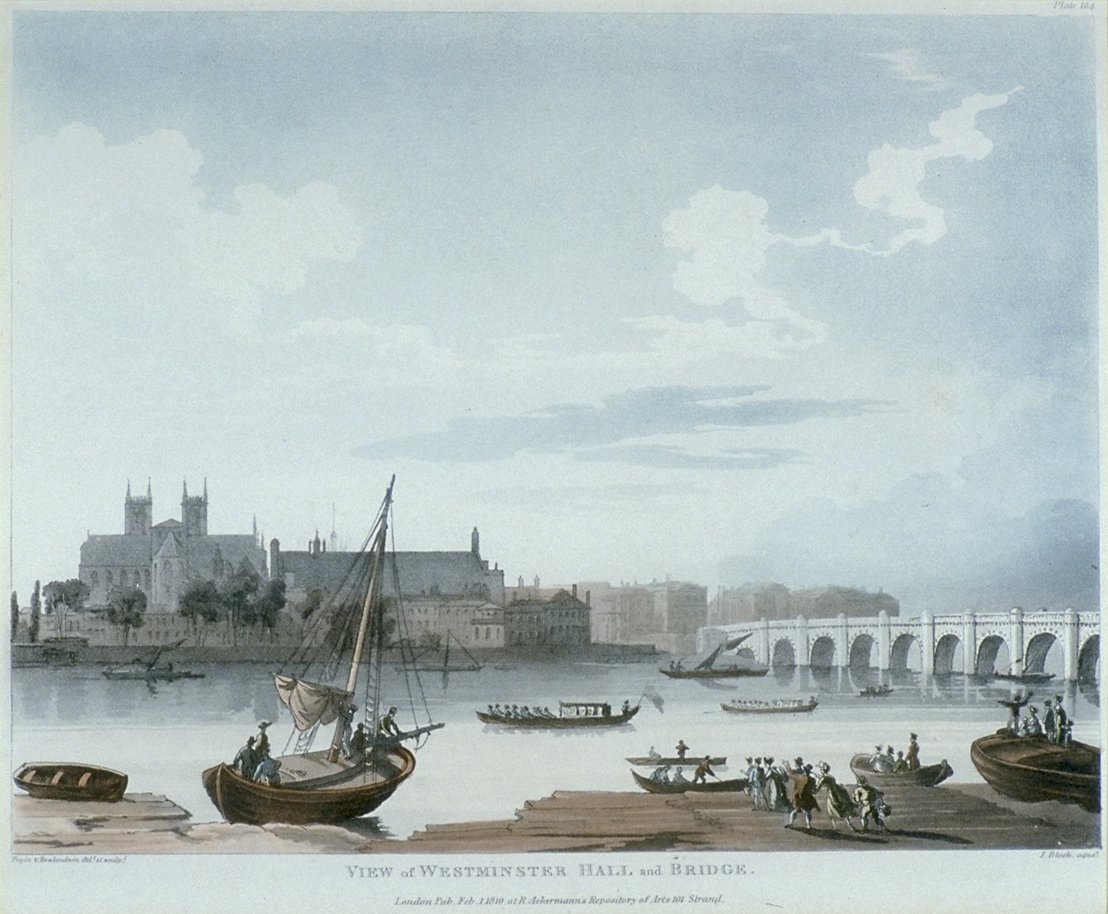View of Westminster Hall and Bridge
Thomas Rowlandson (1756 - 1827)
Auguste Charles Pugin (1762 - 1832)
John Bluck
Coloured aquatint
published 1 February 1810
-
About the work
- Location
-
Country: Korea, Republic of (South Korea)
City: Seoul
Place: British Embassy
This print shows a view of the Thames with the silhouette of Westminster Hall emerging in the distance. Westminster Hall is the most substantial surviving part of the Palace of Westminster. When first built by William II (William Rufus) in 1097, it was some 240 feet long and 40 feet high and was used as a banqueting hall. After the building was damaged by fire in 1291, it was restored by Edward II. Further alterations were made by Richard II between 1397 and 1399, when the walls were elevated by a further two feet, and a stately porch and impressive oak hammer-beam roof were installed. The hammer beam roof is 92 feet high in the center and remains the widest unsupported span in the country.
Westminster Hall became the centre of administrative life; Grand Councils and later Parliaments were held there. From the 13th century until 1882, it was home to the Law Courts, which architect Sir John Soane laid out in 1820–24. Then, the west side of the hall housed the Court of Chancery, the Court of the Queen’s Bench, the Court of Common Pleas and the Court of the Exchequer.
The hall has witnessed numerous significant historical events. For example, Charles I was tried and condemned within it in 1649 and, four years later, Cromwell was installed as Lord Protector there. Others condemned there include Sir Thomas More in 1535, Anne Boleyn in 1536 and Guy Fawkes in 1606. In more recent times the bodies of Gladstone, Edward VII and Churchill all lay in state within the hall.
Today, Westminster Hall is the vestibule of the House of Commons, connected to Sir Charles Barry’s Palace of Westminster (built 1840–66) by St Stephen’s Hall.
This aquatint print was published by Rudolph Ackermann as an illustration to 'The Microcosm of London', a series of aquatints with accompanying texts concerned both with the antiquities of London and contemporary life in the city. Ackermann was the most important publisher of illustrated books in England during the first half of the 19th century. He worked from ‘The Repository of Arts’ (the premises of his publishing business) on the Strand. Issued in monthly installments from 1808 to 1810, The Microcosm of London eventually comprised three volumes, which together contained over 100 illustrations.
-
About the artist
Thomas Rowlandson was born in London, the son of a bankrupt wool and silk merchant. He studied at the Royal Academy Schools, making a trip to Paris during his time there, and won the silver medal in 1777. During the next two decades he made several continental tours, visiting France, Italy, Germany and Holland, as well as travelling extensively in England and Wales. He exhibited from 1775 to 1787 and, in 1789, received a legacy from an aunt, which he is said to have gambled away. From 1798, much of his work was for Rudolf Ackermann, most notably his illustrations for the three Tours of Dr Syntax (published 1812, 1820, and 1821) and The Microcosm of London (1808–10). He revisited France in 1814 and Italy in about 1820. Rowland continued to work almost until the end of his life. He is most famous as a caricaturist, but his work also included figure studies, portraits, marine subjects and landscapes.
Augustus Charles Pugin fled to England in the 1790s, either because of his Royalism or on account of a duel. He seems to have landed in Wales, where he became a friend of the architect John Nash (1752–1835). He worked as a general artist, providing designs for Nash and painting scenery, before moving to London and studying at the Royal Academy Schools. He first exhibited architectural designs at the Academy in 1799 and, from 1807, began to exhibit at the Old Watercolour Society. Pugin worked on several projects for Rudolf Ackermann, including plates for The Microcosm of London and The Abbey Church of Westminster (1811–12). During this period he set up a school of architectural drawing and began to publish his own works. He was the father of A. W. N. Pugin, who designed the interiors of the Houses of Parliament.
John Bluck was an aquatint engraver, mainly of topographical views, but also of marine and sporting subjects after his contemporaries. He produced plates for numerous publications.
-
Explore
- Places
- England, London, Westminster
- Subjects
- topography, townscape/cityscape, river bank, river, man, woman, bridge (urban), abbey, hall, sailboat
- Materials & Techniques
- aquatint, coloured aquatint
-
Details
- Title
- View of Westminster Hall and Bridge
- Date
- published 1 February 1810
- Medium
- Coloured aquatint
- Acquisition
- Purchased from Parker Gallery, November 1971
- GAC number
- 9418